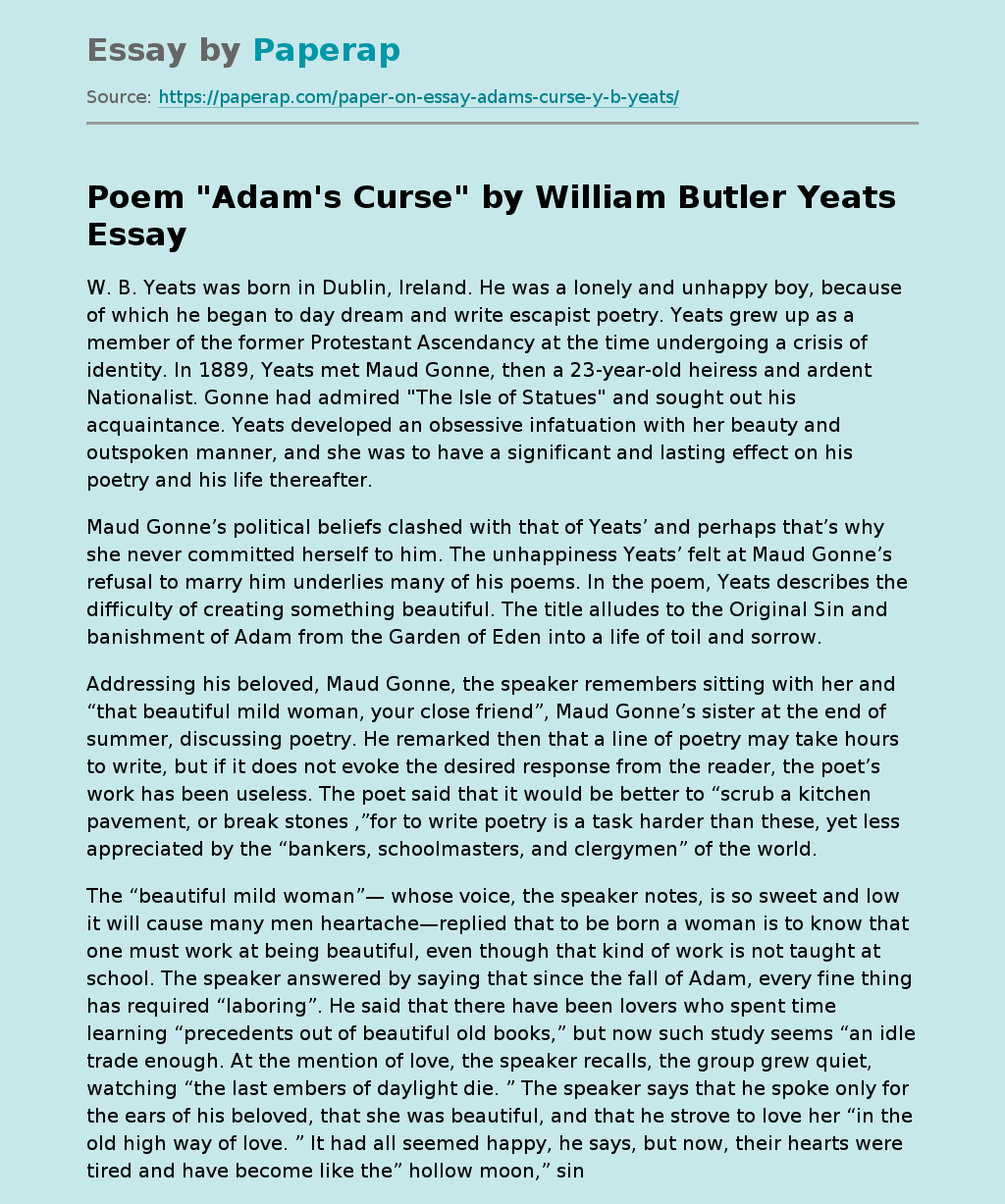Poem "Adam's Curse" by William Butler Yeats
W. B. Yeats was born in Dublin, Ireland. He was a lonely and unhappy boy, because of which he began to day dream and write escapist poetry. Yeats grew up as a member of the former Protestant Ascendancy at the time undergoing a crisis of identity. In 1889, Yeats met Maud Gonne, then a 23-year-old heiress and ardent Nationalist. Gonne had admired “The Isle of Statues” and sought out his acquaintance. Yeats developed an obsessive infatuation with her beauty and outspoken manner, and she was to have a significant and lasting effect on his poetry and his life thereafter.
Maud Gonne’s political beliefs clashed with that of Yeats’ and perhaps that’s why she never committed herself to him. The unhappiness Yeats’ felt at Maud Gonne’s refusal to marry him underlies many of his poems. In the poem, Yeats describes the difficulty of creating something beautiful. The title alludes to the Original Sin and banishment of Adam from the Garden of Eden into a life of toil and sorrow.
Addressing his beloved, Maud Gonne, the speaker remembers sitting with her and “that beautiful mild woman, your close friend”, Maud Gonne’s sister at the end of summer, discussing poetry. He remarked then that a line of poetry may take hours to write, but if it does not evoke the desired response from the reader, the poet’s work has been useless. The poet said that it would be better to “scrub a kitchen pavement, or break stones ,”for to write poetry is a task harder than these, yet less appreciated by the “bankers, schoolmasters, and clergymen” of the world.
The “beautiful mild woman”— whose voice, the speaker notes, is so sweet and low it will cause many men heartache—replied that to be born a woman is to know that one must work at being beautiful, even though that kind of work is not taught at school. The speaker answered by saying that since the fall of Adam, every fine thing has required “laboring”. He said that there have been lovers who spent time learning “precedents out of beautiful old books,” but now such study seems “an idle trade enough. At the mention of love, the speaker recalls, the group grew quiet, watching “the last embers of daylight die. ” The speaker says that he spoke only for the ears of his beloved, that she was beautiful, and that he strove to love her “in the old high way of love. ” It had all seemed happy, he says, but now, their hearts were tired and have become like the” hollow moon,” since all emotions have been drained out. “Adam’s Curse” is written in heroic couplets, which is a name used to describe rhyming couplets in iambic pentameter.
The style is conversational and follows an irregular rhyme scheme. “Adam’s Curse” is an extraordinary poem; and though its stylistic simplicity is somewhat atypical for Yeats, it easily ranks among his best and most moving work. Within an emotional recollection of an evening spent with his beloved Maud Gonne and her sister, Yeats frames a philosophical argument: that because of the curse of labor that God placed upon Adam when He expelled him from the Garden of Eden, every worthwhile human achievement requires hard work.
The speaker loves the woman to whom the poem is addressed, and speaks “only for her ears”; but though the scene seems happy, their hearts are as weary as shells worn by the waters of time. Behind the natural, unsophisticated feel of the poem, lies a great deal of hard work and structure—just as the poem’s speaker says must be true of poetry generally.
The discussion of work and beauty is divided into three progressive parts: the speaker’s claims about poetry, the sister’s claims about physical beauty, and the speaker’s claims about love. This last claim affords Yeats the chance both to hush the trio and to soften the mood of the poem, and the speaker looks outward to the rising moon, which becomes a metaphor for the effects of time on the human heart, a weariness presumably compounded by the labor of living “since Adam’s fall”.
Poem "Adam's Curse" by William Butler Yeats. (2019, Jun 20). Retrieved from https://paperap.com/paper-on-essay-adams-curse-y-b-yeats/

